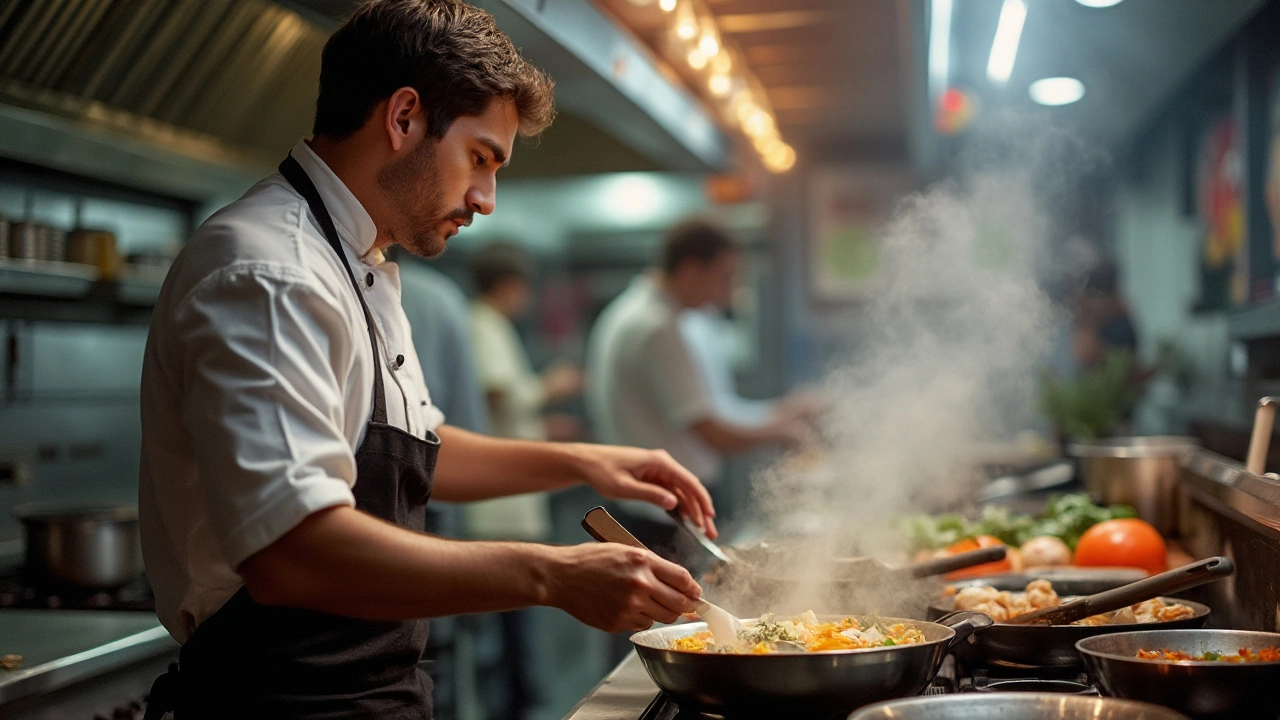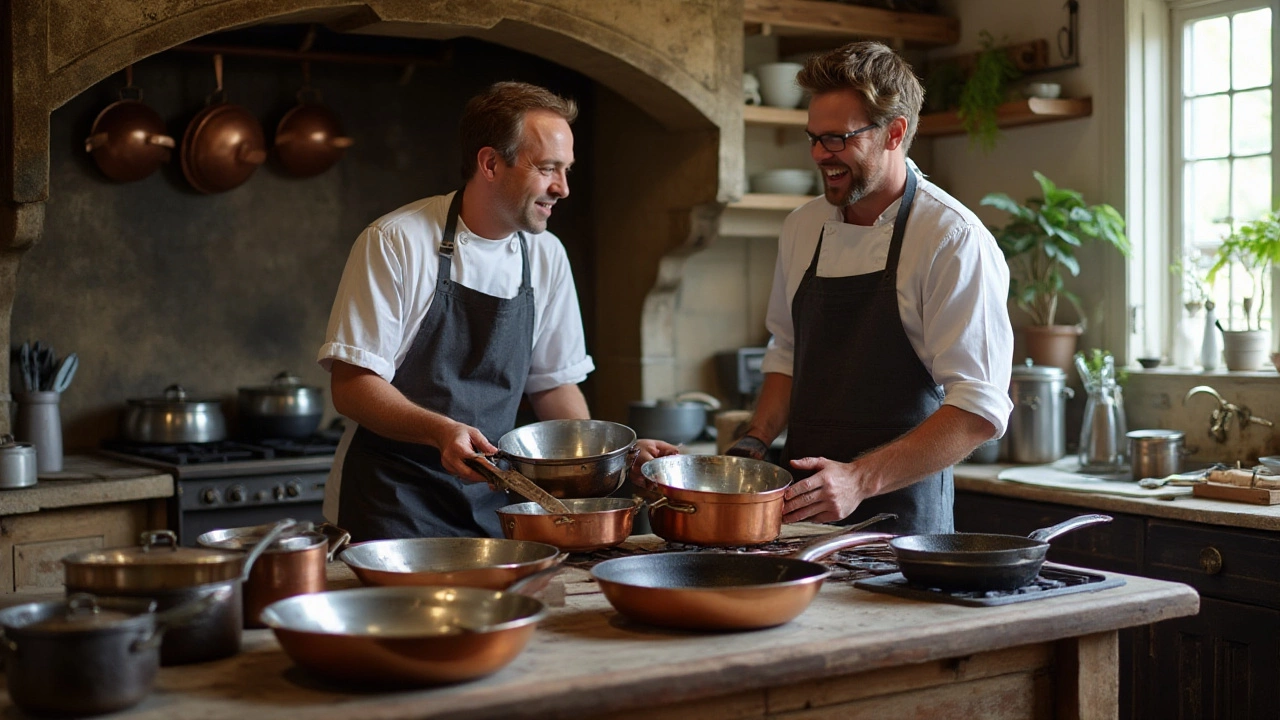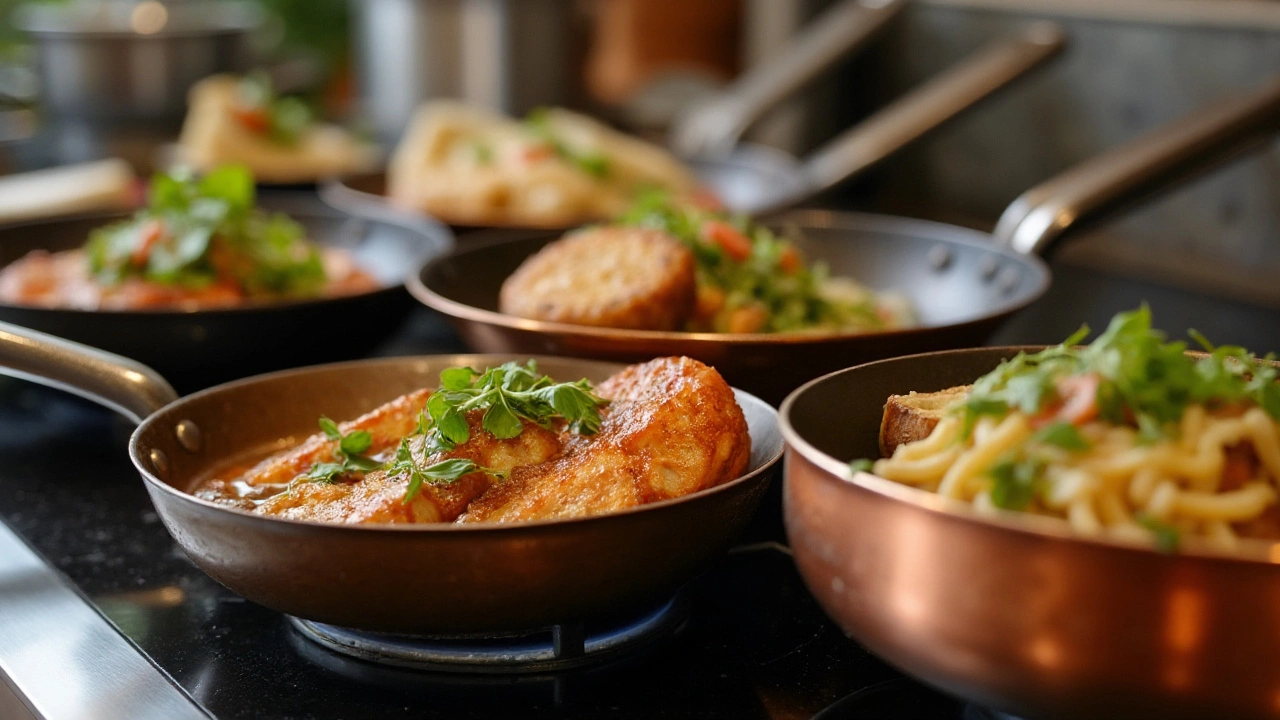The Secret Behind Chefs Avoiding Non-Stick Pans

In bustling professional kitchens, seasoned chefs deliberate over every detail, including the tools they choose to wield. One might find it curious that non-stick pans, often lauded for their convenience, are notably absent from their array of cookware. The reasons behind this choice are more than just a preference—they're rooted in the quest for culinary excellence.
Non-stick surfaces, while making clean-ups a breeze, have their own set of limitations that do not necessarily align with the rigorous demands of professional cooking. From heat distribution to flavor development, each cookware decision impacts the essence and quality of the dish. By exploring these facets, we can unveil the rationale behind why seasoned chefs favor other types of pans, providing insights beneficial to home cooks aiming to elevate their own cooking ventures.
- The Science of Heat Distribution
- Durability and Longevity
- Flavor Development in Cooking
- Versatility of Professional Cookware
- Limitations of Non-Stick Surfaces
- Choosing the Right Pan for the Job
The Science of Heat Distribution
The artistry of cooking hinges significantly on the understanding of heat distribution, a concept that underpins the efficacy of cookware selected by chefs. In any kitchen, from a humble home setup to a prestigious restaurant, heat control can either elevate a dish or lead to its downfall. At the heart of this is the ability of a pan to conduct heat evenly, a quality less pronounced in non-stick pans. These pans are generally made with an aluminum core coated in polytetrafluoroethylene (PTFE), known for its non-stick properties, but they do not excel in evenly spreading heat compared to stainless steel or cast iron alternatives.
When chefs choose their tools, they seek materials that ensure the entire cooking surface of the pan is uniformly heated. This uniformity allows for precision cooking, essential in crafting dishes like the perfect sear on a steak or the intricate flavors of a complex sauce. A pan that does not transfer heat evenly can create hotspots, leading to uneven cooking – a particular disadvantage when cooking delicate proteins or when a consistent texture is crucial. For instance, a skillet made of copper, often favored in professional settings, conducts heat quickly and evenly, making it ideal for tasks that require speed and control.
Moreover, the thickness and material of the pan play a critical role in heat retention, another factor that heavily influences a chef's decision. Cast iron, albeit slower to heat up, excels at maintaining heat. This property is cherished for dishes that benefit from steady cooking temperatures, like braising or baking. Unlike non-stick pans, cast iron improves with age, developing a natural non-stick surface known as seasoning. A copper pan, on the other hand, provides responsiveness, allowing a chef to raise or lower the heat rapidly – a luxury when sautéeing or preparing reductions that require swift adjustments.
Reliance on even heat distribution is so ingrained in professional cooking that many chefs view it almost as an extension of their culinary technique. As renowned chef Craig Claiborne once remarked, "A well-used pan becomes almost a conductor of the cook's own power."
It is not merely about the end result on the plate; it is the entire process that defines the culinary arts.Such philosophical musings underline the importance chefs place on understanding the science behind their tools, and why non-stick pans do not meet these high standards.
Durability and Longevity
When it comes to the realm of professional kitchens, one keyword that stands out among the tools of the trade is durability. In a setting where cookware endures relentless use, fabricating dishes day in and day out, the longevity of a pan becomes crucial. Chefs often lean towards cookware materials such as stainless steel or cast iron, which are not only heat resistant but can also withstand the abrasions of metal utensils, high flame, and repeated scrubbing. The non-stick coating found on some pans, by contrast, tends to degrade and chip away over time, leading to a shorter lifespan. In a professional kitchen where every second counts and reliability is key, this degradation becomes an issue, compelling chefs to rely on their tried and tested alternatives.
The investment in sturdy cookware also pays off in consistency. Seasoned chefs value a pan's ability to maintain a steady and even heat, which is imperative for multi-tasking during peak service hours. Cast iron and stainless steel pans, for example, develop a seasoned surface over countless hours of cooking, enhancing their non-stick properties naturally. This is an asset that non-stick pans seldom provide, given their synthetic coatings. A chef can't afford the unpredictability of a pan's surface degrading in the middle of crafting a fine dish, which is why they opt for materials known to age gracefully.
"When you buy a pan, you're buying a partner," remarked renowned chef Jamie Oliver, emphasizing the vitality of cookware that stands the test of time both in terms of performance and value.
Moreover, the environmental impact of cookware choices also plays a role in their decision-making process. Traditional pans can be restored and maintained through re-seasoning, a sustainable practice that elongates the lifespan of cookware without needing frequent replacements. Non-stick options, however, may enter landfills sooner, contributing to waste due to their shorter lifecycle. This ecological aspect has led many chefs to appreciate long-lasting tools as a conscientious choice, aligning their culinary practices with sustainability values. This preference extends beyond mere practicality; it is an ethos of endurance that fosters an intimate understanding of one's tools, where the cookware becomes an extension of the chef's craft.
Choosing Materials That Last
Among the various choices in cookware, stainless steel and cast iron boast splendid records of durability. Unlike non-stick pans that require gentle handling, these materials are far more robust. Cast iron, prized for its heat retention and even cooking surface, can last a lifetime if properly cared for. Its non-stick capability improves with age and seasoning, transforming it into a family heirloom rather than a disposable item. Similarly, stainless steel, known for its resistance to corrosion and staining, offers reliability over countless uses. While they may require a bit more elbow grease when cleaning, their resilience to scratches and high temperatures guarantees they won't warp or peel, enduring the rigors of the culinary world with grace and grit.
Understanding the attributes of these materials, chefs cultivate a relationship of trust with their cookware. It's not uncommon to see the same set of pans utilized daily, developing a patina of stories and flavors over the years. This continuity fosters a seamless cooking experience, where the predictable nature of a pan's performance aids in crafting perfect dishes. Each use bonds the chef with their tools, creating an unspoken dialogue that informs their culinary instincts. As these seasoned chefs will attest, choosing non-stick pans might simplify cleaning, but what they lose in longevity and reliability offers little consolation to the dedicated professional who seeks a devoted kitchen partner.

Flavor Development in Cooking
When it comes to creating the deep, complex flavors that make dishes irresistible, the choice of cookware can play a significant role. Non-stick pans, although convenient, often fall short in the critical process of flavor development due to their inability to reach and maintain suitable high temperatures necessary for certain cooking techniques. Professional chefs often emphasize the importance of food searing, which is a method used to caramelize the surface of meats and vegetables. This process, known as the Maillard reaction, occurs when amino acids and reducing sugars react to give food a rich, distinctive flavor and is best achieved in materials that can withstand high and even heat. Traditional materials such as stainless steel or cast iron excel here, allowing cooks to brown their ingredients beautifully without sacrificing flavor.
The non-stick coating of common pans can inhibit this process by restricting the pan's ability to stay consistently hot when in contact with food. This can result in a steaming effect rather than a proper sear, which not only diminishes the depth of flavor but can alter the texture of the dish. Moreover, due to the delicate nature of non-stick coatings, they cannot tolerate the high heat needed for deglazing—a technique where after searing, a cook adds liquid to the pan, scraping up the flavorful bits that stick to the bottom. This forms the base of rich sauces and gravies, which is a part of what makes dishes delightful to the senses.
Chefs also prefer pans capable of retaining a fond, the caramelized bits left in the pan after browning that form the foundation for many complex flavors. However, non-stick surfaces typically do not allow for the build-up of these savory nuggets, thus losing out on a crucial element of gastronomic alchemy. In an interview with a renowned chef in “Gastronomy Today,” she affirmed,
"The fond is like the language of the pan; it tells you how your dish is progressing, transforming basic ingredients into something transcendent. Non-stick surfaces often rob us of this crucial dialogue."This eloquently captures the essence of why traditional pans remain a staple among culinary professionals.
Understanding the limitations of non-stick cookware can encourage home cooks to explore other materials that can elevate their cooking. Using stainless steel, carbon steel, or even copper pans not only boosts flavor development but also grants a greater level of control over the culinary process. This shift might seem daunting at first, but the payoff comes in the form of enhanced tastes and textures that bring dishes to life. For those who wish to dive deeper into the world of cooking, investing in quality cookware becomes an investment in a richer culinary experience.
Versatility of Professional Cookware
The realm of professional cookware presents a vast palette of options, allowing chefs to create with immense flexibility. In commercial kitchens, the robustness and multifunctionality of this cookware cater to a chef's desire to employ diverse cooking techniques. From browning to braising to searing, the versatility of these tools is unmatched.
A key attribute is the ability to withstand varying temperatures—unlike non-stick pans, which often have temperature constraints. Professional-grade pans like cast iron, carbon steel, and stainless steel, can endure the searing heat necessary for certain cooking procedures, such as flash frying or caramelizing. Their resilient composition enables chefs to transition effortlessly between stovetop and oven, a capability often limited with non-stick varieties.
Another advantage lies in the texture and surface of materials like cast iron and stainless steel, which aid in the development of fond, the flavorful bits left behind after browning. This is crucial for deglazing and forming rich, complex sauces that elevate dishes’ flavors. Chefs appreciate the nuanced taste achieved through such processes, underscoring why alternative pans reign supreme in professional settings.
Perhaps, the adaptability of professional cookware shines most in its universal application across diverse culinary traditions. A traditional wok, for example, sparks creativity with stir-frying, steaming, and deep-frying. Similarly, a cast iron skillet handles baking tasks as effortlessly as it does grilling. Such diversity not only streamlines operations but also enriches the versatility of the chef reigning over the kitchen.
"Understanding the breadth of a tool's use changes the way we see cooking. Our kitchens aren’t just a mishmash of gadgets and gizmos; they're collections of history and stories waiting to be retold," notes culinary historian, Joanna McMillan.
Moreover, the durability of these pans means they often become investment items, enduring for years, if not decades. Their substantial build gives them an extended lifespan, making them reliable companions through culinary evolutions. This longevity holds significant appeal for chefs keen on maintaining consistent quality and reducing equipment turnover, which can be both disruptive and costly.
Understanding these nuances not only illuminates why chefs commonly steer clear of non-stick pans but also offers a glimpse into the thoughtful decisions shaping the culinary world. For the home cook aspiring to explore chef-like versatility, embracing such cookware paves the way for enhanced cooking engagements that bring out their inner Michelin-starred chef, all while maintaining the charm and delight of cooking at home.

Limitations of Non-Stick Surfaces
Non-stick pans, with their sleek surfaces and promise of easy clean-up, have carved a niche in home kitchens worldwide. Yet, in professional settings, these pans often fall short when tested against the rigorous demands of culinary artistry. One of the primary limitations is their ability to conduct and retain heat evenly. Unlike other materials, such as stainless steel or cast iron, non-stick surfaces often conceal uneven heat distribution, which can lead to poorly cooked food, disappointing the standards chefs strive to uphold.
Moreover, the durability of non-stick pans can be a point of contention. In bustling kitchens, where pans endure high temperatures and swift transitions from stove to sink, non-stick coatings can flake or wear away over time. This not only diminishes the pan’s utility but also poses a health concern as flakes could potentially mix with food. In contrast, cookware constructed from more robust materials like carbon steel offers longevity, becoming a trusted companion for chefs over the years of seasoning and use.
When it comes to flavor development, the adequacy of a non-stick surface is often questioned. The beloved browning effect known as the Maillard reaction, which enriches food with complexity and depth of flavor, benefits from the direct contact between food and metal. Non-stick pans inhibit this process, reducing the potential for flavorful caramelization. This limitation encourages chefs to reach for alternatives that don't sacrifice the intricacies of taste for convenience's sake.
Another aspect to consider is the versatility of professional cookware, a domain where non-stick pans frequently lag. Techniques such as deglazing or making fond are essential in creating sumptuous sauces and reductions. The residue that forms is notoriously difficult to achieve on non-stick, confining their utility in crafting intricate dishes. Alternatives like cast iron or carbon steel excel at these tasks, offering flexibility that enhances culinary creativity.
There's also a growing concern about the safety of non-stick surfaces at high temperatures. Some coatings, when subjected to extreme heat, can release fumes potentially harmful to health. This makes them less desirable for chefs who regularly employ intense heat for searing or stir-frying. As noted by culinary expert Harold McGee, "Professional chefs value equipment that stands up to high heat and intense use without compromise."
While non-stick pans deserve acknowledgment for their contribution to hassle-free cooking, their limitations highlight why professional chefs may shun them. Armed with skill, chefs choose tools that align with their culinary ambitions, paving the way for more precise, flavorful, and adaptable cooking experiences. Their decisions, informed by years of experience, offer valuable lessons for home cooks aspiring to elevate their kitchen practices. Understanding these choices allows one to grasp the essence of professional-grade cooking, where the right pan can make all the difference.
Choosing the Right Pan for the Job
In the art of cooking, the right tool can make the difference between a good meal and a culinary masterpiece. Selecting the proper pan is an essential step for both home cooks and professional chefs, who know that the cookware used will affect everything from cooking time to the flavor profile of their dish. It's not just about what you see on the surface—or in this case, the coating. Each material and shape caters to specific cooking techniques. Let's start with the revered stainless steel pans, prized for their ability to sear meats beautifully, allowing for that crucial fond formation. They provide the perfect canvas for deglazing and creating sophisticated sauces. Their ability to withstand high heat makes them indispensable in tasks where browning and caramelization are desired.
Chefs also lean towards using cast iron, a material renowned for its heat retention properties. A well-seasoned cast iron skillet can be a versatile powerhouse in the kitchen. From baking perfectly golden cornbread to handling a rib-eye steak’s sizzling crust, this pan's qualities are unmatched. Chefs appreciate the rustic charm it brings to a dish and its ability to go from stovetop to oven seamlessly, adding layers of complexity to the cooking process. Don’t forget, a lifetime of use often builds a cherished relationship with this cookware, passing down through generations and carrying with it stories of shared meals and cherished moments.
The Versatility of Copper
Copper pans are another favorite, though used more selectively due to their price. Known for their superb conductivity, they provide precise temperature control, which is essential for delicate dishes. Sauces and sauteed items benefit from their responsiveness to heat changes, allowing chefs to perform intricate techniques requiring meticulous attention. The aesthetic beauty of copper is a bonus, valued not only for its utility but also for the statement it makes in the kitchen. However, it's important to note that they require regular maintenance, as tarnishing is common, but many believe that the performance justifies this effort."The type of cookware one uses can transform the entire cooking experience," says Harold McGee, an authority in the realms of kitchen science and food chemistry.
While it may seem daunting to amass a collection of pans as varied as the meals one might prepare, understanding each pan’s role can simplify the decision. For those new to building their kitchen arsenal, a sensible approach involves starting with a basic triad: a stainless steel saucepan, a cast iron skillet, and a non-stick omelet pan for delicate tasks. Over time, as one’s culinary skills evolve, complementoary pieces, like a carbon steel pan or the occasional copper piece, become useful enhancements.
A kitchen with diverse yet thoughtful kitchen tools ensures that the dishes cooked are not limited by the equipment but are enhanced by it. The mastery behind using each pan effectively turns cooking from a routine task into a passionate exploration of flavors and techniques.
Remember, while non-stick pans have their place, especially for dishes with sticky ingredients or simpler cooking needs, diversifying your cookware will empower you to explore new realms of flavors and textures. Each pan tells its own story and adds its own unique touch to your culinary creations, making the journey into the art of cooking as enjoyable as sitting down to savor the final dish. With this insightful guide, embracing the art of selecting the right pan for each culinary task becomes another enriching part of the cook's ever-evolving journey.





